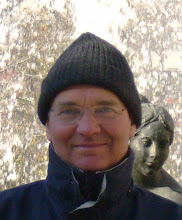
The Hengrove Park scheme includes a new cycle path to replace this cycle lane and is therefore receiving Cycling City funding, even though it was already planned and would have been carried out anyway, so in effect Cycling City funds are subsidising a road widening scheme. Some people think that's OK because there's a benefit to cycling, but does turning south Bristol into a mini Los Angeles with massive road schemes and huge scale development really benefit cycling?

If this cycle route is so important that it is designated as part of the new strategic multi-million pound Cycling City network, why do the authorities think it acceptable to deprive cyclists of what little comfort is afforded by the cycle lane during the road works? Could it be that there is negligible cycling demand on this route and it is being designated as part of Cycling City purely as a pretext for tapping into CC funds?

Hengrove Park was once the site of Bristol Airport (1930 - 1957) and is now looking rather forlorn, so some investment must be welcome, but does it need to be so resolutely car-orientated, with massive areas given over to car parking and access roads? Would it be asking too much for Hengrove Park to be developed as an exemplar of car-free living, given that it could be the focus for a lot of "alternative transport" investment with rapid transit and cycle routes, something worthy of Bristol's Green Capital aspirations?

Back to cycle route closures. Here's a recent example from nothing less than Sustran's National Cycle Route NCN 3, which runs form Bristol to Land's End, which was closed off next to Bristol Dog's Home beside the River Avon south of Temple Meads. The Closure signs didn't even acknowledge it as a cycle route! A diversion along the busy local road network was vaguely indicated.

In this case we find that the closure should only have taken place when works actually required it, yet it remained in place for weeks, including week-ends when absolutely no work was in progress. On one occasion when I visited, the works causing the Path to be closed consisted of two men in hi-viz jackets leaning against a fence (vaguely visible below - click pic to enlarge). Such is the priority accorded to users of the much vaunted National Cycle Network in our Cycling City.





4 comments:
Great post Chris. I've been trying, without success, to get details about rel and proper green designs and technologies to be used in the Hengrove Park development for some time now. Here's an extract of how I blogged about the plans in Sept 2007:
__________________________________
Today I received an A5 envelope in the post addressed to The Occupier (very likely along with many others in South Bristol). It contained an A4 full colour, 8 page brochure detailing the Hengrove Park Regeneration Project, (http://www.hengrovepark.com/) 'a joint public and private sector initiative to redevelop a large former airfield' (actually much, much more like a park for many years, thus Hengrove Park [!], if you ask locals and look at the glossy picture at the top of the brochure). I'm particularly interested in how the development will be 'Built to meet the highest level of design and sustainability standards'. Bristol City Council Leader Helen Holland says the development is '...potentially the jewel in the crown for South Bristol...'...
___________________________________
No sign yet of the 'highest level of design and sustainability' I'm afraid.
You may not be surprised to hear that it's not the same over here. In fact, the road gets closed to keep the cycle path open. This happens quite consistently. I've other examples.
Thanks for that David. I wonder if we should be encouraging our new Executive Member for Transport to go on one of your study tours (I know your answer!).
Although I'm doubtful about it being feasible to adopt Dutch practice over here in hilly Bristol, it does at least show that another way, indeed another world, is possible and may give councillors more confidence to go for radical change.
Okay, let's put my head in the lion's mouth - the whole problem in south Bristol is that much of it was built as a slum clearance programme with no thought for local jobs or the infrastructure to encourage them. There was no thought about proper roads as no one wanted this slum trash to move out of their estates to infect the rest of us.
Central Bristol has changed out of all recognition in the last 30 years which is why service industry find it so attractive. They have led to the rise of the middle class estates in the area where most of the cycling activists live. They want good cycle ways now so they can get to their comfy air-conditioned offices in the city center, and couldn’t give a toss for the thousands in abject poverty just across the fields from them. They, on principle, oppose any projects to open up the area to bring in local jobs for local people (such as the completing of the city’s ring-road, on hold for 50 years), are opposed because they may affect property prices.
Sorry, you may have to ride on small sections of road while improvements are made (those will benefit cyclist too). A city needs to be a community for all its citizens not just the vocal few. If cyclists showed more consideration for others inhabiting the planet I’m sure we could get so much more done.
I am a regular cyclist in Bristol who is deeply saddened by the bigotry of the zealots and the arrogance of the lyra louts. Many cycle ways are too dangerous to use (especially for families) because of dangerous, bad and inconsiderate behaviour of some cyclists. Both these groups give real cyclists a bad name.
Post a Comment